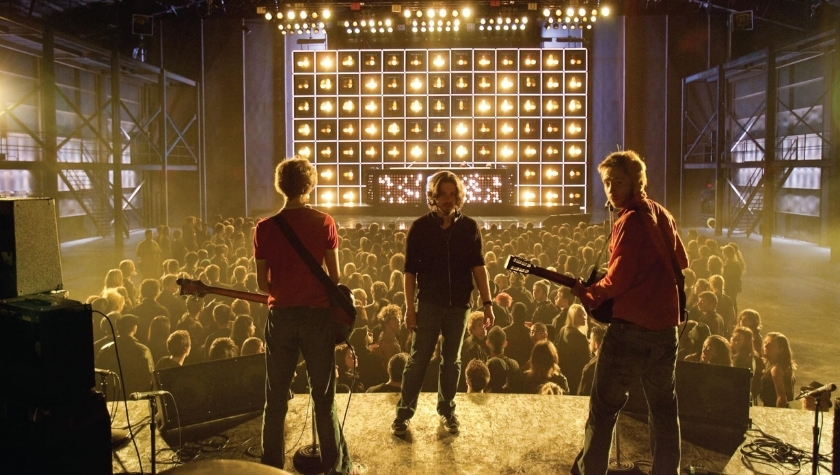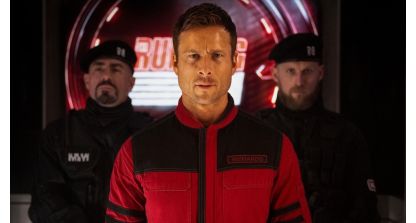In 2004, 30-year-old British filmmaker Edgar Wright exploded onto the international cinema scene with his zombie comedy hit, Shaun of the Dead (2004). Wright’s clever, comic application of genre movie film grammar onto mundane London life helped cement a style that was all his own, and the film turned his friends and lead actors, Simon Pegg and Nick Frost, into stars.
The team went on to make police action-comedy Hot Fuzz (2007) and sci-fi pub-crawl romp The World’s End (2013) to further acclaim, while outside of these collaborations Wright applied his humor, film history prowess and meticulous technique to the cult classic comic book adaptation Scott Pilgrim vs. The World (2010), the car chase heist hit, Baby Driver (2017), and the London-set psychological horror film, Last Night In Soho (2021).
Now, Wright returns to the action genre with a new adaptation of Stephen King’s The Running Man (2025), using a key literary influence of his for a film that’s all his own. The full-tilt action set-pieces, sci-fi world building, and a heavy dose of satiric humor, perfectly exemplify the unique chops that Wright’s been accumulating over 20 years of writing and directing films.
Here are the seven essential screenplays of Edgar Wright.
SHAUN OF THE DEAD (2004)
Wright broke into television direction after making a microbudget feature film with friends in his hometown, the comedy western homage, A Fistful Of Fingers (1995). By 1999 he was seasoned enough to make the sitcom Spaced with comic actors Jessica Hynes and Simon Pegg, who play the lead flatmates alongside Pegg’s comic counterpart Nick Frost. Wright’s cheeky, fast-moving visual style and pop culture saviness was already on full display in the show’s cinematic homages, including a zombie episode that would inspire his breakout film.
Wright and Pegg had so much fun making the episode that they decided to write Shaun Of The Dead (2004) together, a comic take on the George A. Romero zombie films of their youth. Pegg plays the titular Shaun, a lovable loser trying to win back his ex-girlfriend during a quarter life crisis, when a zombie apocalypse hits his North London neighborhood. Frost plays Pegg’s deadbeat friend, Ned, solidifying a comic partnership that would last decades. Wright directed the film with an infusion of high-energy genre tropes into everyday British life, creating a fresh comic tone with a big heart that established his style and made the film a hit.
A decade after Fistful, Wright had finally broken into the mainstream, but rather than move on to someone else’s project, he reunited with his Shaun team for another British genre homage.


HOT FUZZ (2007)
A lifelong lover of high-octane action movies, Wright used the police action genre for one of his very first shorts, Dead Right (1993), shot with friends in his little home village of Somerset. So it’s only natural that after the success of Shaun, Wright returned to Somerset with his new filmmaking family to make the buddy cop comedy, Hot Fuzz (2007). With a higher budget, Wright doubled down on his Shaun ethos, creating a mash-up by hilariously translating the bombastic shoot-em-up flare of Tony Scott and Michael Bay films to pastoral England.
In a role as far from Shaun as he could get, Pegg plays a top notch London supercop who finds himself reassigned to a seemingly peaceful little village. When he stumbles upon a series of murders, he teams up with the chief inspector’s son, played delightfully by Frost, to crack a small-town conspiracy. The climax finds Wright turning the center of his hometown into a John Woo-esque bullet ballet.
With an expansive ensemble of new talent and British acting legends alike, Fuzz doubled the gross of Shaun and solidified Wright as much more than a flash in the pan. Given the opportunity to go bigger, Wright and Pegg embraced what got them there in the first place, working from a place of genuine love and excitement, and it paid off.
SCOTT PILGRIM VS. THE WORLD (2010)
Wright’s Fuzz follow-up saw him leaving England for Canada to create a big screen version of Bryan Lee O’Malley’s Scott Pilgrim comic book series. Following the titular slacker indie rock musician as he’s forced to do battle with his dream girl’s seven evil exes, the premise leant itself perfectly to Wright’s love of misfits, music and martial arts, and gave him the opportunity to work on a big studio scale, building an entirely unique world.
He paired with writer and actor Michael Bacall to write the script, and cast Michael Cera in the lead role, an unlikely action hero who, along with a vast ensemble of up-and-coming millennial stars, did extensive fight training and band practice to nail the elaborate action and musical scenes. The pace and style of Scott Pilgrim vs. The World (2010), was somehow even faster, bolder and more electric than Wright’s first two films.
Even with a starry young cast, unbelievable fight scenes and a rocking soundtrack, the film was a difficult beast to market, and failed to turn a profit. Glowing reviews and ecstatic word of mouth, however, made it a hit at home, and it almost instantly became a beloved cult classic. The stunning result of Wright’s first big studio budget has outlasted many of the year’s more profitable films, becoming a modern classic and key millennial text.


THE WORLD’S END (2013)
Wright kept plenty busy after Scott Pilgrim, producing the alien invasion movie Attack The Block (2011) for his friend Joe Cornish, and collaborating with Cornish and Steven Moffat on the screenplay for Steven Spielberg’s The Adventures of Tintin (2011), which features Pegg and Frost in supporting roles. He and Pegg were meanwhile writing his next directorial effort, the third in what is now known as the Three Flavours Cornetto Trilogy, named for the ice cream treat that appears in all three films. They echoed some horror cues from Shaun, some action cues from Fuzz, and deepened the theme of outcasts fighting back against a homogenizing force, for a Bodysnatchers-esque sci-fi comedy called The World’s End (2013).
In one of his greatest performances, Pegg plays Gary King, a delusional alcoholic so determined to recapture the glories of his youth, that he re-assembles four reluctant hometown friends, including an against-type, straight-edged Frost, to complete a 12-pub crawl. As the crawl progresses, they realize that there’s something off about the town, and an intergalactic conspiracy comes to light.
While the film proved a perfect culmination of the team’s previous collaborations, full of hard-hitting action, layered thematic easter eggs, and big laughs, it’s also the most reflective of Wright and Pegg’s scripts, and its darker themes around the woes of lost youth and the dangers of attempting to recapture former glories, gained it critical plaudits. After the core trio toured the world promoting the film, Wright returned to work on what was meant to be his next film within one of the biggest franchises. But the movie Gods had other plans for him.
BABY DRIVER (2017)
Wright had been attached to make Marvel’s Ant-Man (2015) since before Iron Man (2008) had even come out, but ultimately left the project due to creative differences in 2014, leaving him and his co-writer, Joe Cornish, with a “Story By” credit. It didn’t take him long to bounce back in grand fashion, though, with his first solo screenwriting credit, Baby Driver (2017).
The original, action-packed heist film was influenced by car chase movies like The Driver (1978), but with a musical angle typical of his films. Wright had long been choreographing action scenes to music, and with Baby, the technique became the entire premise of the film. Ansel Elgort plays an expert getaway driver who uses music to block out a bad case of tinnitus, so in order to do what he does best, he has to have just the right song playing. Wright went to great lengths to make sure that every cut, gear shift and gunshot was in time with the movie’s eclectic soundtrack, making for a rock concert experience that blew the roof off of its SXSW premiere.
In a time when it felt like only movies based on IP could succeed, Baby drove its way to $227m world-wide thanks to an ecstatic audience response. After his departure from one of the biggest film franchises in the world, the success of Wright’s original popcorn movie proved a truly inspiring comeback.


LAST NIGHT IN SOHO (2021)
Growing up ingesting the pop culture of his parents’ era, Wright became fascinated with the films and music of the swinging sixties and romanticized the London neighborhood of Soho. But as he grew, he recognized the dark and violent underbelly of the showbiz center’s bright lights. After spending years thinking up a horror film about that world and the dangers of romanticizing the past, Wright finally teamed up with 1917 (2019) writer Krysty Wilson-Cairnes to crack the script of Last Night In Soho (2021).
Thomasin McKenzie stars as an aspiring fashion designer who leaves the country for Central London, only to begin experiencing episodes where she time travels back to the 60s in the form of a singer played by Anya Taylor-Joy. When the visions become increasingly violent and collide with reality, the film morphs into a neon-lit horror fantasia in which Wright employs an abundance of bloody style set against one of his reliably great soundtracks.
Released when audiences were still reluctant to come out to theaters after the pandemic, Soho failed to become a box office hit. But as Wright learned from Scott Pilgrim, the life of a film is a lot longer than its original theatrical run, and Soho is continuing to find new fans and a greater appreciation from film lovers in the years since its release.
THE RUNNING MAN (2025)
A big fan of Stephen King, Wright read his 1982 dystopian sci-fi thriller The Running Man before he saw the 1987 movie version, and recognized how different the film was from the book. So when Paramount set about remaking the film, Wright recognized just how fresh of a film he could make. It gave him the opportunity to make a timely, high-speed action film that tied back to his childhood ambitions while further expanding his skillset. He reteamed with Scott Pilgrim co-writer Bacall and cast Glen Powell as an everyman in a dystopian world, who joins a gameshow where hunters are tasked with hunting and killing him.
The Running Man gives Wright the perfect premise to go wild, fully utilizing his genre mash-up style and propensity for smart comic action, satire and musicality that has made him a totally distinct filmmaking voice. In the two decades since he entered the cinematic landscape, many filmmakers have tried to emulate his style, but there is assuredly only one Edgar Wright.

